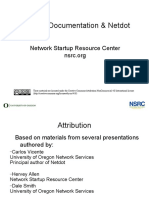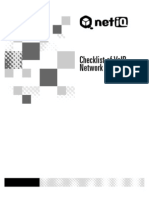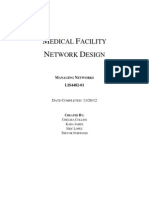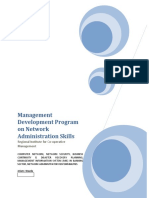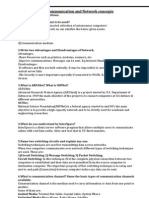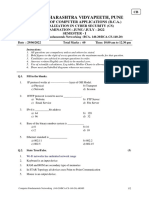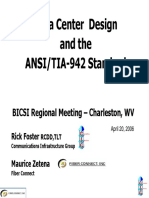Networking Documentation
Networking Documentation
Uploaded by
Adwitiya SaigarCopyright:
Available Formats
Networking Documentation
Networking Documentation
Uploaded by
Adwitiya SaigarOriginal Description:
Copyright
Available Formats
Share this document
Did you find this document useful?
Is this content inappropriate?
Copyright:
Available Formats
Networking Documentation
Networking Documentation
Uploaded by
Adwitiya SaigarCopyright:
Available Formats
Networks and Networking
Group-10
Networks and Networking
(NWN)
Contents
Sr. no.
1.
2.
3.
4.
5.
6.
7.
8.
9.
10.
11.
12.
13.
14.
15.
16.
17.
Topic
Acknowledgement
Certificate
Abstract
Introduction
Network
Transmission media
Topology
Client-server Architecture
Proposed Network Solution
Feasibility Study
Proposed Network Diagram
Distribution of computer and IP
table
Cost Analysis
Network Devices used
Network Security
Conclusion
Reference
Page no.
3
4
5
6
7
9
12
13
15
16
18
21
22
23
26
28
29
Introduction
The CEO of an organization that has just been upgraded to a medium-sized establishment
designed to increase the productivity of their employees, which amounts to 80, personal
computers in 75 of 'its employees in a network. It is help file sharing and quick
Page 1 of 26
Networks and Networking
Group-10
correspondence both inside the organization and even outside. Being in the supply of engine
parts for several cars, the CEO has also identified the need to monitor and protect the orders
made by the manufacturers and the information given so sensitive in their correspondence
through e-mail in particular by the sales staff. In addition, the security and confidentiality of
information relating to the organization's products, accounting and even human resources are
essential because there are plans to increase the number of products sold and employees.
This is a report for the installment of the network, where the division of 75 computers in the
network is occupying the 6th and the 9th floor of the ten storey building.
Departments allocated:
6th floor:
Sales, Accounts and Human resources
9th floor:
CEOs room, research and Development and product design
Here in this report detailed analysis of the feasibility, devices specifications, cost estimation
and the topology used in the network are reported. Also the security issues are also been
discuss with all recommendations for the security and the maintenance of the network,
without being failures are attacks of the intruders.
Page 2 of 26
Networks and Networking
Group-10
Network
Network refers to the collection of two or more nodes i.e. computer systems, printers,
scanner, hardware, software etc connected together communication channel. Networking
refers to connection of nodes through common communication channel for sharing and
transfer of data, resources and information among interconnected devices.
http://www.home-network-help.com/images/xp-router-network.jpg
Types of Network:1) LAN LAN stands for Local area network. It is a network that connects computers
and devices in a limited geographical area such as home, school, computer laboratory.
Mainly LAN network uses wired network based on Ethernet technology.
2) WAN WAN stands for Wide area network. It is a computer network that covers a
large geographic area such as a city, country. Mainly WAN uses a communications
Page 3 of 26
Networks and Networking
Group-10
channel that combines many types of media such as telephone lines, cables, and air
waves.
3) MAN MAN stands for Metropolitan area network. It is a large computer network
that usually spans a city or a large campus.
Advantages of Network:1) Speed Sharing and transferring files within Networks are very rapid.
2)
Cost Individually licensed copies of many popular software programs
and installing of hardware on individual system can be much more costly.
3)
Security Sensitive files and programs on a network are passwords
protected or designated as copy inhibit so that illegal authority cant use,
copy or tamper file.
4)
Centralized Software Management Software can be loaded on one
computer and can be used by other computers eliminating the need to spend
time and energy installing on independent computers.
5)
Resource Sharing Resources such as, printers, fax machines and
modems can be shared.
6)
Electronic Mail E-mail serves as personal and professional
communication. Electronic mail on a LAN can enable staff to communicate
within the building eliminating the need to leave their desk.
7)
Flexible Access Access their files from computers throughout the firm.
Page 4 of 26
Networks and Networking
Group-10
Transmission medium
Transmission medium describes the type of physical system used to carry a communication
signal from one system to another. It is most important part in establishing the network. There
are mainly two types of medium used in transferring data from system to another which are:1) Wired Technology Wired Network is usually accomplished by using cables and
other hardware to physically connect one computer to another. Different cables used
to establish Wired network are:a)
Twisted pair cable: - A type of cable that consists of two independently insulated
wires twisted around one another. The use of two wires twisted together helps to
reduce crosstalk and electromagnetic induction. It is the least expensive and most
widely used medium for telecommunication. The transmission speed ranges from
2 million bits per second to 100 million bits per second. Two types of Twisted pair
wire used are:
Unshielded twisted pair cable,
Shielded twisted pair cable.
https://users.cs.jmu.edu/bernstdh/web/common/lectures/images/twisted-pair-cable.gif
b)
Coaxial cable: - A type of wire that consists of a center copper or aluminum wire
surrounded by insulation of a flexible material with a high dielectric constant and
then a grounded shield of braided wire which is a conductive layer. The shield
Page 5 of 26
Networks and Networking
Group-10
minimizes electrical and radio frequency interference. It is widely used for cable
television systems, office buildings, and other worksites for local area networks.
Transmission speed range from 200 million to more than 500 million bits per
second.
http://www.intelligenceunited.com/wp-content/uploads/2010/04/coaxial-cable.png
c)
Optical fiber cable: - A fiber optic cable consists of a bundle of glass (or plastic)
threads (fibers), each of which is capable of transmitting messages modulated onto
light waves, which are wrapped in protective layers. It is not affected by
electromagnetic radiation. Transmission speed may reach trillions of bits per
second. The transmission speed of fiber optics is hundreds of times faster than for
coaxial cables and thousands of times faster than a twisted-pair wire.
http://www.yourdictionary.com/images/computer/FIBER288.GIF
2) Wireless Technology Wireless network is used to describe interconnection of
nodes without using any physical connection or wired, but rather the network is
connected by radio waves and/or microwaves to maintain communications. This type
Page 6 of 26
Networks and Networking
Group-10
of connection is generally used in some type of remote information transmission
system. Different technology used to establish Wireless network are:a) Terrestrial microwave: - Terrestrial microwaves use Earth-based transmitter and
receiver. Terrestrial microwaves use low-gigahertz range, which restrictions all
communications to line-of-sight. Path between dispatch stations spaced approx, 30
miles apart.
b) Communications satellites: - The satellites use microwave radio as their
telecommunications medium which are not deflected by the Earth's atmosphere.
The satellites are stationed in space, typically 22,000 miles above the equator.
c) Cellular and PCS systems: - Use several radio communications technologies.
The systems are divided to different geographic areas. Each area has a low-power
transmitter or radio relay antenna device to relay calls from one area to the next
area.
d) Wireless LANs: - Wireless local area network use a high-frequency radio
technology similar to digital cellular and a low-frequency radio technology.
Wireless LANs use spread spectrum technology to enable communication
between multiple devices in a limited area.
e) Infrared communication: - It transmits signals between devices within small
distances not more than 10 meters peer to peer without any interruption in the line
of transmitting.
http://www.mobilecommstechnology.com/projects/irda/images/img1.jpg
Page 7 of 26
Networks and Networking
Group-10
Topology
Network topology is the design model of interconnections of the different elements (i.e.
links, nodes, etc.) of a computer network. Network topologies may be physical or logical.
There are five main type of topology which is as follows:a)
Mesh topology: - In Mesh topology, each node is connected to other
nodes in the network which is also called fully connected network. It
is a type of networking wherein each node in the network may act as
an independent router and allows for continuous connections and
reconfiguration around broken or blocked paths.
b)
Star topology: - In Star topology, all devices are connected to a
central hub. All traffic that passes through the network passes
through the central hub. The hub acts as a signal booster or repeater.
Star networks are relatively easy to install and manage.
c)
Tree topology: - In Tree topology, a central node (top level) is
connected to one or more other nodes (second level) with a point-topoint link between two levels. Nodes at second level are also
connected to one or more other nodes that are one level lower in the
hierarchy (third level) connected also with a point-to-point link.
d)
Bus topology: - In Bus topology, each computer or server is
connected through some kind of connecter to a single cable called
Bus or backbone. A terminator is required at each end of the bus
cable to prevent the signal from bouncing back and forth on the bus
cable.
e)
Ring topology: - In Ring topology, every node in a network is
connected in a closed loop or ring and every node acts as a signal
boosters or repeaters. The signal passes through each node
connected to the ring in one direction. It utilizes a token passing
scheme to control access. By utilizing this scheme, only one node
can transmit signal on the network at a time.
Page 8 of 26
Networks and Networking
Group-10
Client-Server Architecture
Server: A server is software or a series of computers that links other computers or electronic
device. They store the web pages or databases etc. in it so that user can gain access to them in
the form of user requests from the Client end.
There are almost the entire structures of internet based upon Client- Server model for
example:
1.
2.
3.
4.
5.
6.
7.
World Wide Web.
Domain Name System.
E-mail.
FTP
Chat.
Online gaming.
Database Servers.
Client: A Client is an application or system that access to remote computers or the servers. A
client sends requests to the server to get results.
Three types of clients:
1. FAT CLIENT.
It is a type of client that performs the data processing operation itself and does
not rely on the server.
2. THIN CLIENT.
It is a type of client that uses the resources of the host (server). A thin clients
job is to just display graphically anything provided by the application server,
which performs all the data processing in the servers end.
3. HYBRID CLIENT.
It is a mixture of FAT and THIN client. Just like FAT client it does the local
processing where as relies on server for storage.
Thus, the Client server model is a
distributed
application structure that partitions tasks
or
between the provider of the resource or
service
servers and service requesters called
Clients.
For example: Users accessing the data
from their client
computers application or browser to send
a request or store
Page 9 of 26
workloads
called
Networks and Networking
Group-10
data in the database of the server. On request the server retrieves the data from the database
and displays it on the screen of the clients.
Further many business applications use the protocols such as HTTP, SMTP, Telnet and DNS.
Advantages of Client server architecture
1. Centralization access, resources, and data security are controlled through the server.
2. It gives greater ease of maintenance. It can be replace, repair, upgrade or even relocate
a server while its clients remain unaware and unaffected by the change
3. Scalability any element can be upgraded when needed
4. The data are stored in the database of the server, which gives greater security controls
even if the clients are not maintained. Also servers can control access and resources of
the clients with appropriate permissions may access and change data.
5. Flexibility new technology can be easily integrated into the system
6. Accessibility Server can be accessed remotely and across multiple platforms.
7. New technologies are available to enhance the security, friendliness of the user
interface and ease of use.
Disadvantages of Client server architecture:
1. Dependability The whole system depends upon the server if the server goes down
then all the network based operation will come to a halt.
2. It causes network congestion. It may occur when the link is carrying much data that
its quality of the service decreases. Its effects may be queuing delay, packet loss or
blocking of new connections
3. Typically, the central server computer must be powerful enough to maintain and share
resources with the other computers on the network. This entails a substantial cost.
Page 10 of 26
Networks and Networking
Group-10
Proposed Network Solution
After a detailed analysis on the situation given in the project we have came to such a
conclusion. As we have to configure whole network in a building so the type of network used
in the installation of the network is LAN (Local Area Network) using wired connection to
connect among the computers in the network of the company.
Advantages of using wired network:1. It cost very nominal charges in the installation and the devices used
such as switches, Ethernet cables etc. are less in cost.
2. It has more reliability.
3. Wired LANs have superior performance.
4. The security system is installed in every system.
Wire: For the connection of the clients and peripherals in the
network with the central node we are using UTP
(Unshielded twisted pair cables) of CAT-5(category 5). It
gives transmission up to 100 Maps as required and
segments up to 100 meters. And it is cost effective
technique to the proposed type of connection.
Using the wired LAN we have to choose a topology. After deep analysis we come to the point
to choose upon the Extended Star Topology.
Extended Star Topology: It is a type of network same as the star topology which has one or
more repeater in the extension of the network from the central node to the peripherals or the
clients. For physical extended star topology repeaters are replaced by with hubs or switches.
http://www.ccnastudyguide.net/wpcontent/uploads/2009/07/Extendedstar-topology-300x300.jpg
Page 11 of 26
Networks and Networking
Group-10
Feasibility Study
We have done Feasibility Study to judge the feasibility of a new project
. It is actually a preliminary analysis of a project that lets the people whether proceeding with
a project is worthful or not. Feasibility study is very important for a project which makes an
analysis of all the aspects of a project, external and internal factors influencing it, all the costs
associated with it. It also makes an estimate of how much sales are to be expected and what
profits would the project make. The result of the feasibility study tells weather it is logical to
proceed with it or not.
We have done Feasibility study on four basis:1. Technical Feasibility: - This analysis tells us about the technology we are using to
configure the network of the organization is practically possible, suited to the
organization and weather the technology is up to date or not. As we have use nested star
(tree) topology, wired media for network and Twisted pair cable for wiring which is
practically a good configuration as we have to configure the whole network in a building,
topology suits the design of departments as given and transfer rate and security within a
department. Wired media helps in maintaining a good strength of signal and transfer rate.
By using two servers we ensure back up of data in second server in case of failure of first
server.
2. Schedule feasibility: - This analysis tells us about the time period given to complete to
complete the project is sufficient or not. Typically this means estimating how long the
system will take to develop, and if it can be completed in a given time period. Schedule
feasibility is a measure of how reasonable the project timetable is. As we have been
given six week to design the network of the organization which is sufficient for our
group.
3. Operational Feasibility: - This analysis tells us about the degree to which a proposed
network diagram solves organization problems or takes advantage of organization
opportunities. It also refers to a system that users will accept and use effectively to
support organization objectives. As we have use nested star (tree) topology and using
different switch for every department, we ensure security and high transfer rate of data
within a department.
4. Economic feasibility: - This analysis tells us about the weather estimated cost of the
project is suitable to organization and under its budget and also anticipated value of the
Page 12 of 26
Networks and Networking
Group-10
benefits greater than projected costs of development of network. As we have calculated
the estimated cost in configuring the network this is Rs 2, 39,300 which is under
organization budget and profit would be greater than it after implementing.
Page 13 of 26
Networks and Networking
Group-10
Proposed Network Diagram
Sixth floor Diagram
Page 14 of 26
Networks and Networking
Group-10
Ninth floor Diagram-
Page 15 of 26
Networks and Networking
Group-10
Overall Diagram
Page 16 of 26
Networks and Networking
Group-10
Distribution of Computer and IP
Table
Total number of computer
: 75 computers
Total number of departments : 7 departments
Router
IP 192.172.20.1
Server
IP 192.172.20.2 and 192.172.20.3
Department
Sales department
Accounts Department
Human Resource Department
CEOs Room
Research and Development
Product design Department
Network client/server Room
Page 17 of 26
No. of computer
10
5
6
3
23
23
5
IP
192.172.20.4 to 192.172.20.13
192.172.20.14 to 192.172.20.18
192.172.20.19 to 192.172.20.24
192.172.20.25 to 192.172.20.27
192.172.20.28 to 192.172.20.50
192.172.20.51 to 192.172.20.73
192.172.20.74 to 192.172.20.78
Networks and Networking
Group-10
Cost Analysis of network
Configuration
The following cost estimation has been done for the required proposed network system in the
organization. Since there are Sales, Accounts and Human Resource Department on sixth floor
and CEOs room, Research and development, Product design department and Network
server/client room on the ninth floor. The sixth and ninth floor has to be connected together
and on doing the required research work following equipment will be required to complete
the networking of all the departments above mentioned in a particular topology is given.
REQUIREMENTS
Servers
Switches
Router
Twisted pair unshielded cable
Copper cross over wire
RJ connecter
Kaspersky Antivirus 2011
Total
Page 18 of 26
AMOUNT
2
10
1
500 meters
500metres
180 pieces
PRICE
Rs 25,000
Rs 4,500
Rs 75,000
Rs 20/meter
Rs75/meter
Rs 10/piece
NET AMOUNT
Rs 50,000
Rs 45,000
Rs 75,000
Rs 10,000
Rs 37,500
Rs 1,800
Rs 20,000
Rs 2,39,300
Networks and Networking
Group-10
Network Devices used
1) Server:
It is system or computer that provides services to other computer in the network to access
information or application or data. It needs a very high configuration in comparison to
normal computers. For a reliable and secure server with features like redundant power,
HDDs and predictive failure analysis can help
run a business confidently
For example: Server configuration of IBM
System x3400 M3 Express
2 Way Tower Server, Intel Xeon Quad
Core
Processor
E5506,
2.13GHz,
4MB Cache, 800MHz, 2GB Memory
DDR3, 250GB SATA 3.5 Simple Swap HDD, up to 4bays,Raid 01 in built
2) CAT 5e cable: As for the LAN connection we are using cable line. For best option on
regards to the feasibility we are using CAT 5e cable. It is a class from unshielded
twisted pair cables designed for high signal integrity. It gives the required frequencies
up to 100 MHz It has 4 twisted pair in the single cable jacket. The connector used is
the RJ-45 connector.
Some characteristics
Wire size
0.205 mm2
Temperature operating
-55 to +60
Pair colors
Green, blue, orange, brown
3) Router: It is an electronic device that interconnects
two or more computer networks and selectively
interchanges packets of data between them. Each data
packet contains address information that a router can
use to determine if the source and destination are on
the same network, or if the data packet must be
transferred from one network to another. A router is a networking device whose
software and hardware are customized to the tasks of routing and forwarding
information. Works on Network layer.
4) Switch:
Page 19 of 26
Networks and Networking
Group-10
A network switch is a device used to connect
network segments. It is a small hardware device
that joins multiple computers together in a LAN. It
functions on the basis of the IP of each computer.
It stores the IP of each computer and forwards the
data or information to the exact destination. It helps in reducing traffic congestion in
the network. It works on OSI layer 2(Data link layer)
IKS-6324 Series by MOXA Rackmount Ethernet switch.
Meets UL 60950-1, NEMA TS2, EN50155/EN50121-4, and DNV/ GL certifications
Universal power supply range, 12/24/48 VDC or 110/220 VDC/VAC
redundant dual 12/24/48 VDC power inputs
-40 to 75C operating temperature range
Interfaces:
a. RJ- 45 ports 10/100BASET(X)
b. Full/half duplex mode.
Connection10-pin terminal block
5) RJ connecter: - A registered jack (RJ) is a standardized physical network interface
both jack construction and wiring pattern for connecting telecommunications or
data equipment to a service provided by a local exchange carrier or long distance
carrier. The standard designs for these connectors and their wiring are named RJ11,
RJ14, RJ21, RJ48, etc.
6) Crossover cable: - A crossover cable connects two devices of the same type, for
example - switches DTEDTE or DCE-DCE, usually connected asymmetrically.
7) Gateway: It is a device in the network node which works as an interface with the
other network that uses different protocols. It works on the OSI layer Transport layer,
Session layer, Presentation layer, Application layer.
8) Network Interface Card: It is a hardware device that works as an interface between
the network and the computer i.e. allows network capable device to access the
network. The NIC exists in the data link layer (OSI layer 2).
Page 20 of 26
Networks and Networking
Group-10
9) Repeater: It is a device that receives the signal and regenerates an amplified signal to
retransmit the signal.
10) Line Driver: a device to increase transmission
distance by amplifying the signal. Base-band networks only.
Page 21 of 26
Networks and Networking
Group-10
Network Security
This section focuses the on the security of the network. The first security step starts from the
authenticating the user (i.e. username and password). After being authenticated the second
step is to install a firewall in the server that enforces access policies like the services are only
allowed to the people of the organization or the company. This prevents unauthorized access
to the network. Although it may fail computer worms or Trojans being transmitted over the
network, for that an antivirus software or an IS (internet security software) can be used.
Controlling end user access:
By Creating an account and assigning a password are only small parts of giving someone
access to the network. A network administrator also has to determine other account
parameters such as when an end user can access the network, what groups the user is
associated with, what files he or she can access, and limitations on network and server
resources. User should not be given concurrent login privileges (i.e. single sign-on).
Firewall:
A firewall is program or software or network that is designed to block unauthorized access
while permitting authorized communication. It is set of device that is configured to permit or
deny network access based upon a set of rules (protocol) and other criteria.
Types of firewall to be installed are
Network layer firewall: for the low level TCP/IP
protocol stack. It does not allow passing through the
firewall unless they match the established protocols
set in the firewall.
Application layer firewall: It works at the application
level of the TCP/IP stack. It also intercepts all packets
travelling to or forms an application. It inspects all the packets for improper contents,
and restricts or prevents spreading of the impostor from spreading over the network.
Antivirus:
Page 22 of 26
Networks and Networking
Group-10
Antivirus is a software used to prevent, detect and remove malware, viruses, worms and
Trojan horses. It also prevents and removes adware and spyware. For a network it is
recommended to install an antivirus program in every system including server to prevent
spreading and entering of impostors.
http://www.kaspersky.com/au/images/boxes/r2_workspace_uk.jpg
Back-ups:
To secure the information and databases of the company or the organization keeping backups
is also an important. Calamities, natural disaster, server breakdown or the building can get
fire or explosions. So, there is need of recent backup at the alternate locate for the survival of
the company.
Encryption technology:
Further specified to cryptography, it can be used as a tool to provide privacy, to authenticate
the identities of communication parties and to ensure message integrity. Encryption is the
process of scrambling the contents of a file or message to make it unintelligible to anyone not
in possession of the key required to unscramble it.
Page 23 of 26
Networks and Networking
Group-10
Conclusion
The report on the installation of a network in the company has given us an opportunity to
learn a great deal of new concepts of networking. The network is to be installed keeping in
concern of all the feasibilities and estimation of the cost and variable reliability, so the
network designed proposed is a very suitable network for the company. After much analysis
of the network installation specification the use of wired LAN connection, extended star
topology and the specified device will give much enhancement to the network.
We have implemented the various technologies in the installment of the network. Like the
client-server architecture of the network. The type of connection for the network which we
are using wired LAN as it is easy to install and reliable by cost too. As there are different
departments in different storey of the building we have use a feasible topology for the
network and that in the extended star topology. And each computer will be connected with a
specific IP address for the transmission of the data or information.
Also with concern of the security, we are installing an antivirus program in the server side as
well as the client side so that the impostors may not get spread over the network
Lastly the network installation cost estimation is being tried to keep minimal.
Page 24 of 26
Networks and Networking
Group-10
Reference
Website reference:1. Network and Communication Protocol
available: http://eta305.wordpress.com/2007/08/
last access: 25th September 2010 at 10:30 p.m.
2. NETWORKS, Types of Networks,Advantages of Network,Disadvantages of Networks,
OSI model, Internetworking, Bits, frames, packets and segments, Broadcasts, Protocol,
Wireless LANs.
available: http://homepages.uel.ac.uk/u0306091/Network.htm
last access: 27th September 2010 at 4:43 p.m.
3. Cat5e Cables - Imported & Locally Assembled Category 5e Patch leads, StraightThrough, Crossover, UTP, STP
available:http://www.connectworld.net/au_cabling/category_5e-cables.html
last access: 26th September 2010 at 09:15 p.m.
4. Generic 24 Port 10/100 Switch (5 Year Warranty) (WTEH2400M) | Techbuy Australia
available: http://www.techbuy.com.au/product.asp?at=51&prodid=65867
last access: 24th September 2010 at 11:54 p.m.
5. What is coaxial cable? - A Word Definition From the Webopedia Computer Dictionary
available: http://www.webopedia.com/TERM/C/coaxial_cable.html
last access: 27th September 2010 at 10:30 p.m.
6. What is fiber optics? - A Word Definition From the Webopedia Computer Dictionary
available: http://www.webopedia.com/TERM/F/fiber_optics.html
last access: 26th September 2010 at 11:57 p.m.
7. What is network? - A Word Definition From the Webopedia Computer Dictionary
available: http://www.webopedia.com/TERM/N/network.html
last access: 25th September 2010 at 06:30 p.m.
8. What is twisted-pair cable? - A Word Definition From the Webopedia Computer
Dictionary
available: http://www.webopedia.com/TERM/T/twisted_pair_cable.html
last access: 27th September 2010 at 10:45 p.m.
9. Computer network - Wikipedia, the free encyclopedia
available:
http://searchmobilecomputing.techtarget.com/sDefinition/0,,sid40_gci546288,00.html
last access: 27th September 2010 at 07:13 p.m.
10. Network topology - Wikipedia, the free encyclopedia
available: http://www.atis.org/atismembers.shtml
last access: 24th September 2010 at 08:30 p.m.
11. Moxa Rackmount Ethernet Swtich - IKS-6324 Series 22+2G-port Gigabit unmanaged
Ethernet switches
available: http://www.moxa.com/product/IKS-6324.htm
last access: 25th September 2010 at 10:30 p.m.
Page 25 of 26
Networks and Networking
Group-10
BOOK REFERENCE:1) Stalling ,William (1998). Data and Computer Communication . 7th ed. New Delhi:
Prentice-Hall of India Private Limited. 169-174.
2) Breyer, R., Riley, S (2000). Switched, Fast, and Gigabit Ethernet. 3rd ed. NEW DELHI:
Macmillan Technical Publishing. 289-291.
Page 26 of 26
You might also like
- Network Documentation TemplateDocument21 pagesNetwork Documentation TemplateEngMohamedReyadHelesy100% (2)
- Network Documentation TemplateDocument16 pagesNetwork Documentation Templatesmartstudentin40% (5)
- Sample School Network DocumentationDocument29 pagesSample School Network Documentationadamjamis100% (6)
- VDR G4 Manual Steinsohn PDFDocument185 pagesVDR G4 Manual Steinsohn PDFVariya Dharmesh100% (2)
- Application Guide 200731A1 BBMD RevADocument8 pagesApplication Guide 200731A1 BBMD RevANinh Quang TrườngNo ratings yet
- Network Documentation TemplateDocument4 pagesNetwork Documentation TemplateIbrahim EnwuzorNo ratings yet
- Network Documentation SheetDocument1 pageNetwork Documentation Sheetdeowor6608No ratings yet
- Network Design ProjectDocument11 pagesNetwork Design ProjectMike KennedyNo ratings yet
- Customer Name Here: Technical Run Book Network DocumentationDocument10 pagesCustomer Name Here: Technical Run Book Network DocumentationMyrvin FernandezNo ratings yet
- How To Set Up A Home NetworkDocument10 pagesHow To Set Up A Home NetworkRyansmith MoussaNo ratings yet
- Design Document Template v3 1Document5 pagesDesign Document Template v3 1mahesh sthaNo ratings yet
- The Black Art of LOLADocument16 pagesThe Black Art of LOLAGio AttoliniNo ratings yet
- Windows Administrator L1 Interview QuestionDocument6 pagesWindows Administrator L1 Interview Questionbalraj1100% (2)
- Planning A Network Infrastructure Design ProjectDocument8 pagesPlanning A Network Infrastructure Design ProjectrishabhnagpalNo ratings yet
- HK - Baseline IT Security Policy PDFDocument31 pagesHK - Baseline IT Security Policy PDFsivextien100% (1)
- RP - RZ Support Riso Connectivity SRC TrainingDocument66 pagesRP - RZ Support Riso Connectivity SRC TrainingLeonNo ratings yet
- Network Documentation: (Zti Cyber Cafe)Document8 pagesNetwork Documentation: (Zti Cyber Cafe)dinorenzNo ratings yet
- Network Documentation and NetdotDocument37 pagesNetwork Documentation and NetdotislamNo ratings yet
- Network Documentation and Netdot PDFDocument36 pagesNetwork Documentation and Netdot PDFROSARIO IVONNo ratings yet
- Network Documentation Series Network Sheets Template V0.0.0Document42 pagesNetwork Documentation Series Network Sheets Template V0.0.0Javier Redome100% (2)
- Network Documentation and AuditingDocument4 pagesNetwork Documentation and Auditingdarklittleman100% (1)
- 1 Read Me First: Instructions and Guidelines For IP Address Plan/Inventory WorkbookDocument13 pages1 Read Me First: Instructions and Guidelines For IP Address Plan/Inventory Workbookw1234rNo ratings yet
- Network Documentation ChecklistDocument1 pageNetwork Documentation Checklistoctavio80No ratings yet
- Network Digram DocumentDocument1 pageNetwork Digram Documentcarlk2004No ratings yet
- Server Documentation Policy DraftDocument2 pagesServer Documentation Policy DraftLou Albert LaurelNo ratings yet
- Student Projects 2018 2019Document11 pagesStudent Projects 2018 2019tuyambaze jean claude100% (2)
- Basics To Configure A CISCO Router To Connect To InternetDocument4 pagesBasics To Configure A CISCO Router To Connect To InternetKurniawan Setyo Nugroho100% (1)
- VoIP Network Design ChecklistDocument3 pagesVoIP Network Design ChecklistJonathan AkisanmiNo ratings yet
- IT ChecklistDocument3 pagesIT ChecklistAmit BhardwajNo ratings yet
- Checklist For Designing of Local Area NetworkDocument1 pageChecklist For Designing of Local Area NetworkHumayun KhanNo ratings yet
- 4.3.3.4 Lab - Configure HSRPDocument7 pages4.3.3.4 Lab - Configure HSRPjb100% (1)
- How To Troubleshoot Network Adapter Problems in WindowsDocument41 pagesHow To Troubleshoot Network Adapter Problems in WindowsShivakumar S KadakalNo ratings yet
- Ask - Asks The User Whether or Not The Traffic Is Allowed To Pass ThroughDocument7 pagesAsk - Asks The User Whether or Not The Traffic Is Allowed To Pass ThroughVikashTiwariNo ratings yet
- Ch07 - Wired and Wireless LAN - Q&ADocument21 pagesCh07 - Wired and Wireless LAN - Q&ATuan Doan100% (1)
- Cisco RouterDocument14 pagesCisco RouterRoberto BaruNo ratings yet
- Subnetting PracticeDocument12 pagesSubnetting PracticeClaudia Mohamed Samir0% (1)
- CCNA Questions and AnswersDocument14 pagesCCNA Questions and AnswersBinh TieuNo ratings yet
- NetworkingDocument29 pagesNetworkingzafarabbasmalikNo ratings yet
- Medical Facility Network DesignDocument13 pagesMedical Facility Network Designchelseacollins22No ratings yet
- Network Assessment ReportDocument6 pagesNetwork Assessment ReportconyanchaNo ratings yet
- Run Commands Window/service StartedDocument17 pagesRun Commands Window/service StartedDeepti Ranjan MaharanaNo ratings yet
- System Administrator Resume SampleDocument2 pagesSystem Administrator Resume Sampleresume7.com92% (12)
- Cisco Network Foundation Protection OverviewDocument10 pagesCisco Network Foundation Protection OverviewRyanb378No ratings yet
- Cisco Router Configuration CommandsDocument5 pagesCisco Router Configuration CommandsRakesh KumarNo ratings yet
- Ubiquiti Home Network ExampleDocument96 pagesUbiquiti Home Network ExampleRabbids RabbidsNo ratings yet
- 10 Ways To Fix The Blue Screen of Death On Windows - WikihowDocument14 pages10 Ways To Fix The Blue Screen of Death On Windows - WikihowEng.Mohamed AboulfotohNo ratings yet
- 2.3.3.5 Lab - Configuring A Switch Management AddressDocument8 pages2.3.3.5 Lab - Configuring A Switch Management AddressNicolas Bonina33% (3)
- There Are Five Passwords Used To Secure Your Cisco RoutersDocument4 pagesThere Are Five Passwords Used To Secure Your Cisco RouterscarolatuNo ratings yet
- Tshoot - Chapter 1Document31 pagesTshoot - Chapter 1Che Aiman Che ZulkipliNo ratings yet
- MIKROTIKDocument544 pagesMIKROTIKAbdul Rasyid Musthafa100% (1)
- Maintenance ChecklistDocument8 pagesMaintenance ChecklistAngNo ratings yet
- Network Installation Proposal ExamplesDocument14 pagesNetwork Installation Proposal Examplesandrewicompucare100% (1)
- 5.1.2.13 Lab - Configuring OSPFv2 On A Multiaccess Network - ILM PDFDocument13 pages5.1.2.13 Lab - Configuring OSPFv2 On A Multiaccess Network - ILM PDFMaksim Korsakov95% (20)
- IT Final Documentation 1Document16 pagesIT Final Documentation 1Amol KhadkeNo ratings yet
- Information Technology: Project Report On NetworkingDocument11 pagesInformation Technology: Project Report On NetworkingArjun VashishtaNo ratings yet
- ch-6 WWWDocument46 pagesch-6 WWWMillo NovinNo ratings yet
- Management Development Program On Network Administration SkillsDocument43 pagesManagement Development Program On Network Administration SkillsJelamDavdaNo ratings yet
- Chapter One: 1.1 Network Design OverviewsDocument10 pagesChapter One: 1.1 Network Design OverviewsEric GabrielsonNo ratings yet
- Learning Outcome 1: Arrange, Plan and Prepare For Configuration TaskDocument6 pagesLearning Outcome 1: Arrange, Plan and Prepare For Configuration TaskDakila Chea BetacheNo ratings yet
- Networking Vsaq, SaqDocument16 pagesNetworking Vsaq, Saqbaluchandrashekar2008No ratings yet
- Computer Network: "Computer Networks" Redirects Here. For The Periodical, SeeDocument11 pagesComputer Network: "Computer Networks" Redirects Here. For The Periodical, Seeabhijeetmorey87No ratings yet
- CSEC IT NOTES - Term 2 Week 11 - Computer Networks Lecture 1Document58 pagesCSEC IT NOTES - Term 2 Week 11 - Computer Networks Lecture 1kxng ultimateNo ratings yet
- Ls s5328c Ei 24s DatasheetDocument5 pagesLs s5328c Ei 24s DatasheetAntar Al-mubarziNo ratings yet
- 4-The Alcatel NSS SolutionDocument28 pages4-The Alcatel NSS SolutionBasel wesamNo ratings yet
- 5G Industrie SummitDocument19 pages5G Industrie SummitcosmicduckNo ratings yet
- 3KC69646KAAATRZZA - V1 - 1830 Photonic Service Switch (PSS) Release 10.0 DCN Planning and Engineering Guide (Switching Applications)Document136 pages3KC69646KAAATRZZA - V1 - 1830 Photonic Service Switch (PSS) Release 10.0 DCN Planning and Engineering Guide (Switching Applications)Abdou Abdou100% (1)
- B Cisco Vxlan Config v1Document44 pagesB Cisco Vxlan Config v1MyoNo ratings yet
- Computer Fundamentals Networking-1Document2 pagesComputer Fundamentals Networking-1rp15891815No ratings yet
- Price ListDocument13 pagesPrice ListyashcomputerNo ratings yet
- WAP6807 - Users - Guide - 5.17 5.50 Ed 1 Min CompressedDocument117 pagesWAP6807 - Users - Guide - 5.17 5.50 Ed 1 Min CompressedFacu TrigoNo ratings yet
- Air Ap1832i e k9 Datasheet PDFDocument5 pagesAir Ap1832i e k9 Datasheet PDFKerees JavaNo ratings yet
- Asee13 LteDocument10 pagesAsee13 LtePete AirNo ratings yet
- Attachment ReportDocument45 pagesAttachment ReportBENARD KIMARU RotichNo ratings yet
- Westermo Eltec Ds Cybox-Rt-3-WDocument2 pagesWestermo Eltec Ds Cybox-Rt-3-WdejectdNo ratings yet
- CCN PPT (Compatibility Mode)Document12 pagesCCN PPT (Compatibility Mode)dharmder898No ratings yet
- Cisco SD-WAN (1) 2093489054263191810Document109 pagesCisco SD-WAN (1) 2093489054263191810haiquan190990No ratings yet
- AWS - Difference Between Internet Gateway and NAT GatewayDocument4 pagesAWS - Difference Between Internet Gateway and NAT GatewayAniruddha DasguptaNo ratings yet
- TVL - Computer Systems Servicing 12Document7 pagesTVL - Computer Systems Servicing 12KibasuperNo ratings yet
- 4.3.9 Packet Tracer Configure Site To Site VPN Answer KeyDocument4 pages4.3.9 Packet Tracer Configure Site To Site VPN Answer Keymalaklmawt0000No ratings yet
- Final Ip PackingDocument27 pagesFinal Ip PackingAhmed ElMasryNo ratings yet
- MINT CP User ManualDocument51 pagesMINT CP User ManualDERRIC JOSEPHNo ratings yet
- +3.3Vstb For AVDDA: WWW - Fineprint.cnDocument11 pages+3.3Vstb For AVDDA: WWW - Fineprint.cnAung HeinNo ratings yet
- Exploring QUIC ProtocolDocument8 pagesExploring QUIC ProtocolshreyashNo ratings yet
- Elyzium Technologies PVT LTDDocument25 pagesElyzium Technologies PVT LTDnishapari009No ratings yet
- Powered by D-Link Rg-S5750e Series Security and Multi-Services Switch Da...Document21 pagesPowered by D-Link Rg-S5750e Series Security and Multi-Services Switch Da...Kapil SinghNo ratings yet
- Data Center Design and The ANSI - TIA-942 Standard (PDFDrive)Document61 pagesData Center Design and The ANSI - TIA-942 Standard (PDFDrive)Clement Chan100% (2)
- Io MultiplexingDocument19 pagesIo Multiplexingsubramanyam62100% (1)
- OLT1404A/OLT1408A: 1U Pizza Box 4/8-Port GPON OLTDocument4 pagesOLT1404A/OLT1408A: 1U Pizza Box 4/8-Port GPON OLTJanilson LopesNo ratings yet
- CS-13 Fall 2024 Lectures 13 and 14Document24 pagesCS-13 Fall 2024 Lectures 13 and 14kinam.bscs23seecsNo ratings yet



















